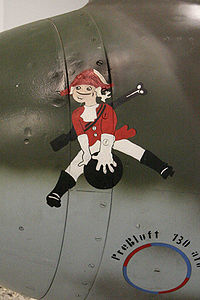Jagdgeschwader 400
|
Jagdgeschwader 400 |
|
|---|---|
 Squadron badge |
|
| active | December 1, 1944 to March 7, 1945 |
| Country |
|
| Armed forces | Wehrmacht |
| Armed forces | air force |
| Branch of service | Air force |
| Type | Jagdgeschwader |
| structure | Squadron staff and 3 groups |
| Location | Staff Brandis I. Group Brandis II. Group Stargard III. Brandis group |
| equipment | Messerschmitt Me 163 |
| Second World War | Air raids on the Leuna Works |
| Squadron commodors | |
| First commodore | Major Wolfgang Spate |
The Jagdgeschwader 400 was an association of the Luftwaffe in World War II . It was the only Luftwaffe squadron that was equipped with the Messerschmitt Me 163 , an object protection interceptor with rocket propulsion .
Lineup
The 1st squadron was set up on April 26, 1944 in Wittmundhafen ( Lage ) from the 20th squadron of Jagdgeschwader 1. The 2nd season and the group staff followed in July 1944 in Venlo ( Lage ) in the Netherlands. On November 12th, the staff of Group II and the 5th and 6th squadrons were set up in Stargard ( Lage ). The III. The group was formed on July 21, 1944 at Brandis Air Base ( Lage ), initially under the name of the supplementary squadron of the Jagdgeschwader 400 (Erg.St.JG 400). On October 14, 1944, the IV. Group of Supplementary Hunting Squadron 2 was formed in Udetfeld ( Lage ). It was not until December 1944 that it was finally renamed III./JG 400 with the 13th and 14th season. Now a squadron staff has also been formed at Brandis Air Base. The squadron was equipped with the Messerschmitt Me 163 .
history
Due to the operational characteristics of the Messerschmitt Me 163 as an object protection interceptor, Group I flew its first missions from the Brandis Air Base near Leipzig. From there it was supposed to attack US bomber formations, which regularly attacked the Leunawerke hydrogenation plant in Leuna in order to disrupt fuel production. In addition, she was subordinate to the 1st Fighter Division in the Luftflotte Reich under the 1st Fighter Corps.

In May 1944, the first 13 brand new Messerschmitt Me 163B-1s arrived. The first, as yet unsuccessful, operation took place on July 28, 1944, when six Me 163 took off against a formation of 596 four-engine B-17 Flying Fortresses that were on their way to the Leunawerke. From December 1944, Group II was also stationed in Brandis. Together with Group I, she flew missions against US bombers. On April 19, 1945, the I. Group was disbanded. Group II moved to Salzwedel ( Lage ) in February , to Nordholz ( Lage ) in April and to Husum ( Lage ) in May 1945 . There she reached the end of the war. The III. The group and its predecessor unit was based in Udetfeld in Upper Silesia from September 1944.
Overall, the operational readiness of the squadron suffered from the lack of jet fuel and trained pilots. By the time the squadron was disbanded in March 1945, 16 kills had been made.
Commanders
Squadron commodors
| Rank | Surname | time |
|---|---|---|
| major | Wolfgang Spate | December 1944 to March 1945 |
Group commanders
- I. group
- Captain Robert Olejnik, December 1944 to November 2, 1944
- Captain Wilhelm Fulda, November 25, 1944 to April 19, 1945
- II group
- Captain Rudolf Opitz, November 1944 to April 1945
- Erg.St.JG 400 / III. group
- First Lieutenant Franz Medicus, July 21, 1944 to October 13, 1944
Known squadron members
- Albert Falderbaum (1913–1961) was an aerobatic pilot
- Rudolf Opitz (1910-2010) was a glider pilot and test pilot
- Wolfgang Late (1911-1997) from 1956 until 1962, when Lieutenant Colonel of the Air Force of the Armed Forces , stage manager for Aviation Safety
- Mano Ziegler (1908–1991), was a test pilot, journalist and writer
literature
- Wolfgang Dierich: The air force associations 1935-1945 . Outlines and short chronicles one document. Ed .: Wolfgang Dierich. Verlag Heinz Nickel , Zweibrücken 1993, ISBN 3-925480-15-3 (703 pages).
Individual evidence
- ↑ Henry L. deZeng IV: Air Force Airfields 1935-1945 Germany (1937 Borders) pp 78-79 , accessed on 15 March 2020
- ↑ Horst Boog : The German Reich and the Second World War , Volume 7, Deutsche Verlags-Anstalt, Stuttgart 2001, ISBN 3-421-05507-6 , p. 268.
- ↑ Henry L. deZeng IV: Air Force Airfields 1935-1945 Germany (1937 Borders) pp 489-491 , accessed on 15 March 2020
- ↑ Henry L. deZeng IV: Air Force Airfields 1935-1945 Germany (1937 Borders) pp 299-301 , accessed on 15 March 2020
- ↑ Horst Boog: The German Reich and the Second World War , Volume 10/1, Deutsche Verlags-Anstalt, Stuttgart 2008, ISBN 978-3-421-06237-6 , p. 824.